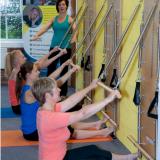The Props

In yoga class, you can use specific props like blankets, blocks, or a strap to ease into poses, and Pilates mat work similarly uses props like flexbands, fitness circles and foam rollers. However, a large repertory of exercises in Pilates has been created on machines, like the Pilates reformer or Cadillac, which are vastly more intricate than the props used in yoga. The machines use heavy springs to create resistance and are incredibly versatile, taking the mat work to different levels — providing support to make exercises easier or adding resistance to challenge the muscles more. If people desire to tone and sculpt then the apparatus used in Pilates can do this to a higher degree than can be achieved in yoga.
Calories burned
Yoga is considerably more static than Pilates due to poses being held for a number of breaths, except for flowing methods of yoga like Vinyasa and Ashtanga which are more dynamic. Pilates classes generally are designed to flow from one move to another or to be performed in repetitions of 5-10. Most yoga classes are 75 to 90 minutes, while Pilates classes are generally an hour. Generally more calories are burned in Pilates and due to the muscle building possibilities in Pilates your metabolism can increase. Yoga can have the ability to slow down metabolism so if weight loss is a goal then yoga is not the best choice. However, yoga can have major positive effects on mood, stress and mental health by helping the mind to clear, focus and reflect.
Rehabilitation
Pilates has been used for many years in multiple fields of rehabilitation to assist better movement and reduction of pain. The Australian Physiotherapy & Pilates Institute, Stott Pilates and Polestar Pilates (I have been trained in the latter two) have been influenced in their content by Physiotherapists. Brent Anderson, who developed the Polestar method, believes the apparatus developed by Joseph Pilates can help restore faulty movement patterns and support those with injury to become more functional. Although Yoga can be fantastic for improving flexibility it is not generally promoted for back care and rehabilitation.
Summary
The two practices enrich each other greatly, and the more anatomically specific elements taught in Pilates enhance the more abstract images used in yoga. Focusing primarily on one method alone can lead to imbalances in that “yogis” can often become over flexible and less stable in their pelvis and spine while Pilates enthusiasts can often become tight and held in their core muscles which can leave them unable to “let go” and be more mobile. A combination of both methods would lead to a very balanced and controlled body.



